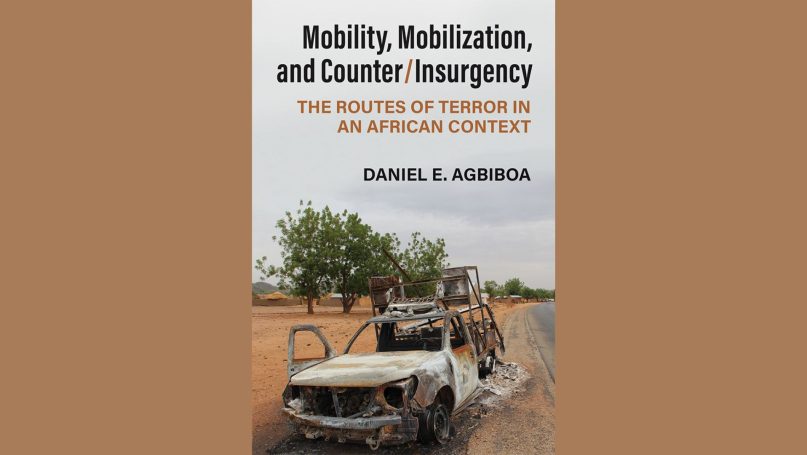
Mobility, Mobilization, and Counter/Insurgency: The Routes of Terror in An African Context
By Daniel E. Agbiboa
University of Michigan Press, 2022
Following the September 11 terrorist attack on U.S. soil, securitization of people’s mobility became a heightened topic. It also received considerable attention in mainstream discourse as a part of national security debates. However, this was only the beginning. Discussions on how to tackle terrorism, through the launching of the “war on terror” in large part, resulted in mobility being viewed as a potential security threat in several contexts. The growing fear of terrorist attacks brought by immigrants in many societies, particularly the western ones, reinforced the use of discriminatory technologies such as state surveillance, biometric border control tolls, and checkpoints. In recent years, numerous academic research, books, and popular articles have been published on the issue of mobility and mobilization. Despite this, the important role played by mobility in facilitating the mobilization of insurgency is often overlooked in both popular discourses as well as academic research.
Mobility, Mobilization, and Counter/Insurgency bridges this gap between the mobility literature and conflict studies by analyzing the security implications of mobility in terms of insurgency, using the case study of one of Africa’s, more specifically Nigeria’s notorious jihadist groups, Boko Haram. He sheds light on the logic of mobility in matrices of armed conflict in the context of Africa’s Lake Chad Basin region, expanding our understanding of “how constellations of mobility and immobility shape insurgency and counterinsurgency” (p.19).
To craft his main arguments and show us how the intersection of mobility, space, insurgency and other structural factors – such as inequality, power, and identity – play significant roles in violent conflict occurrences, Agbiboa takes us to the scenes of his fieldwork in Borno, Yobe and Adamawa states in the Northeast Nigeria, for a period between 2017 and 2019. These areas are highly affected by Boko Haram’s mobilities as well as their insurgency. To support his arguments, the book is empirically grounded on data collected from this fieldwork. Moreover, to develop a more in-depth understanding of the main subject of the study, mobility, Agbiboa applies an ethnographic method through in-depth interviews, focus group discussions, informal discussions as well as observational studies at checkpoints in the field. More interestingly, Agbiboa joins road transport workers, particularly truck drivers to discover more about Boko Haram’s operations, and the Nigerian state security forces’ attitudes towards drivers at the various checkpoints throughout their journeys.
Chronologically, the book starts by addressing the disconnect between mobility and insurgency in popular discourses and academic research. While doing this, Agbiboa highlights the paradox of globalization in terms of mobility. Basically, what this paradox of mobility demonstrates is that mobility, which is often viewed as a source of freedom in our modern world, can also be used by governments in certain countries as a suppression tool against certain groups. This can be due to their religious, ethnic, racial, and social class belonging. Chapter One to Chapter Four all explore the ways in which mobility is used by Boko Haram to mobilize its insurgency. It also provides insights into the role played by factors such as youth bulges, motorbikes as well as special terrain in this complex dynamic. Meanwhile, Chapter Five explores how the Nigerian state security forces mobilize for counterinsurgency operations and how they try to use mobility to disfranchise the group. Finally, Agbiboa tries to conclude the book by shedding some light on the policy implications of these new findings.
While providing a broader theory that offers a new mobilities paradigm, Agbiboa takes into account the “spatial and temporal dynamics of insurgencies, as well as the structural conditions that produce and sustain violence along transit routes and in people’s lives” (p.170). Consequently, he advances our understanding of how mobility and mobile infrastructures are used by jihadist insurgents and state security forces to sustain their respective operations over time. Thus, in the context of spiralling violence, mobilities can shape the form of insurgency employed by a jihadist group such as Boko Haram, and the counterinsurgency strategy adopted by state security (which in this case is the Nigerian state security). This new mobilities paradigm does not only challenge (1) the popular discourses, which show “conflict terrains as spatially fixed geographical containers for insurgent and counterinsurgent processes, and geography as a neutral backdrop in which terrorist activities occur” (p.ix), but also (2) the western representation of movement in Africa as chaotic and dangerous.
By doing thus, Agbiboa’s new paradigm also confronts scholars and policymakers to turn their attention to certain structural drivers for the mobilization of insurgency, often viewed as less important in the literature. This contribution is an important one for social sciences research in general, but more particularly the conflict and mobility literature. The determinants and drivers for insurgency, as well as how to mitigate the spread of this form of security threat, have preoccupied scholars in various disciplines (e.g., political science, psychology, and human geography) in both the contexts of Africa and other world regions. Yet, there has been a disconnect between mobility and insurgency studies, with mobility research paying less attention to insurgency, and vice versa. The lack of comprehensive studies on the insurgency-mobility nexus has not only posed barriers to our understanding of the role played by mobilities, through movement and transportation, on conflict onset, but may have had implications on the effectiveness of policy concerning this specific topic.
From a political scientist scholar’s perspective, the central argument in Mobility, Mobilization, and Counter/Insurgency speaks volumes to both future researchers and policymakers in terms of conflict dynamics in contemporary Africa. Showcasing how Nigeria’s Boko Haram operates, as well as the Nigerian state’s response to the insurgency, through mobility, is a perfect demonstration of how the “war on terror” is currently playing out in Africa’s Lake Chad Basin region. It sheds light on the implications of this phenomenon on the livelihoods of mobile subjects in this specific context, a new insight that should not be taken for granted.